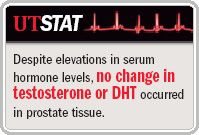Article
TRT appears prostate-safe in 6-month trial
Atlanta-Testosterone replacement therapy (TRT) caused no adverse events in the prostate tissue of men with androgen decline of aging male (ADAM) syndrome after 6 months of treatment, according to a study presented at the AUA annual meeting here.

Use of testosterone supplementation in aging men is increasing, despite concerns that the safety and potential adverse events of such treatment are largely unknown. Randomized trials of TRT in older men are needed to address these issues.
Leonard S. Marks, MD, medical director of the Urological Sciences Research Foundation, Culver City, CA, and colleagues performed the 6-month, double-blind, randomized, placebo-controlled trial of testosterone supplementation in 44 men between the ages of 50 and 75 years. They found that, although testosterone and dihydrotestosterone (DHT) levels increased in the serum of men receiving TRT, no change in the levels of either androgen was observed in the prostate tissue.

Biopsy also was performed at study completion. Two biopsy cores were snap-frozen for evaluation of tissue hormone levels, and 12 cores were used for histology and biomarker studies of cell proliferation (Ki-67, MIB-1), stroma-epithelial ratio, androgen receptor, angiogenesis (CD34), and gene-expression profiling. Prostate volume was measured by magnetic resonance imaging. The study was powered to detect a 25% increase in DHT in prostate tissue.
"The successful use of biopsy cores to evaluate tissue androgens longitudinally is an important spin-off from the study," Dr. Marks said.
Key inclusion criteria included symptoms of hypogonadism as measured by a positive Morley score, morning serum testosterone level <300 ng/dL, and PSA levels <10.0 ng/mL.
Exclusion criteria included prostate cancer, drugs that affect the pituitary-gonadal axis, and testosterone treatment within the past 6 months. Baseline characteristics in the treatment arms were matched for age (mean, mid-60s), race (about half non-Caucasian), screening testosterone levels (mean, mid-200s ng/dL), and the major prostate measures of PSA, prostate volume, voiding symptoms, and urinary flow rate.
Prostate tissue unaffected
Testosterone-treated men exhibited a marked increase in serum testosterone and DHT, from below 300 to about 680 ng/dL and from about 30 to 50 ng/dL, respectively (p<.01). Hematocrit increased by 4.7 + 2.9% over baseline (p<.05).
Despite these elevations in serum hormone levels, no change in either androgen occurred in prostate tissue. In addition, no treatment-related changes were found in histology of the prostate, in stroma-epithelial ratio, and in the major biomarkers for cell proliferation, androgen receptor, or microvessel density. Nevertheless, Dr. Marks added a note of caution.
"Establishment of prostate safety for large populations of older men undergoing lengthy testosterone replacement therapy requires further study. Careful monitoring of men receiving testosterone replacement therapy is mandatory, particularly for prostate changes," he said.
Gene microarray of nuclear material from prostate epithelial cells revealed no treatment-related change in the expression of six critical genes in the prostate: PSA, androgen receptor, NKX3, the acid phosphatase PAP2A, the angiogenic factor vascular endothelial growth factor A, or the multifunctional gene clusterin.





